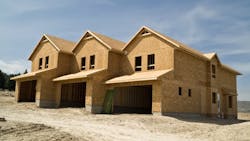Why Building Smaller May Not Be a Solution for Affordability
In the past, it was common for Americans to move to cheaper, suburban areas to afford larger homes, but that's changing. While the average size of new homes has slightly decreased over the past five years, rising land, labor, and lending costs mean that smaller homes aren’t as affordable as they once were, according to property data provider Cotality.
Cotality data from February 2025 show that the median price of a newly built home under 1,500 square feet was $430,000. In most U.S. housing markets, that means homebuyers now need to earn well above the national average in order to afford what would once have been considered an entry-level or starter home.
The connection between home size and location
Looking back to 1940, the average new home measured 1,100 square feet. Jump to 2015, and that square footage had doubled. One reason: As homebuyers sought more affordable homes farther from city centers where land was cheaper and zoning regulations less restrictive, homebuyers could purchase more generously sized homes and still afford to own.
But, as the analysis from Cotality points out, that link between larger homes and suburban development has its limits:
Generally, larger homes yield higher margins, which has long driven the trend toward American suburbanization. However, these far-flung lots eventually have diminishing returns. At the periphery of suburbia, land becomes cheaper to the point where the economies of scale can no longer offset the price to build, and developers turn back to urban environments to redevelop existing properties. Often, these urban infill projects require larger budgets to redevelop and are limited by a variety of interests that restrict the type of new homes that are acceptable.
So, why aren't there more starter homes?
It's partly a supply issue: With costs rising across the board, the share of smaller, new-construction homes has dropped since 2011.
Currently, just 20% of new-construction homes measure less than 1,500 square feet, compared with 32% in 2011.
And builder profitability is under pressure, with material and land prices putting the squeeze on builders trying to offer these smaller housing options. Material costs alone are a significant factor. Price increases for materials have gone up by double-digits during the past year, and the Trump administration's tariffs will only serve to push home construction costs even higher. Building smaller units is a challenge, which is why there's a pressing need to restructure how the U.S. approaches housing affordability.
More aspects of building smaller homes
- As Home Sizes Shrink, Hallways Are Disappearing: With the push for more budget-friendly housing, the no-hallway trend is expected to continue
- Homes Are Getting More Expensive—but Smaller: The average home worth $1 million or more has shrunk by 70 square feet in the past five years
- 4 Small Homes That Showcase Great Design: These designs prove that small can still be exceptional
- More Young Americans Are Abandoning the Starter Home Idea: As costs for starter homes climb, Gen Zers and Millennials say they'd rather wait and save for their forever home
